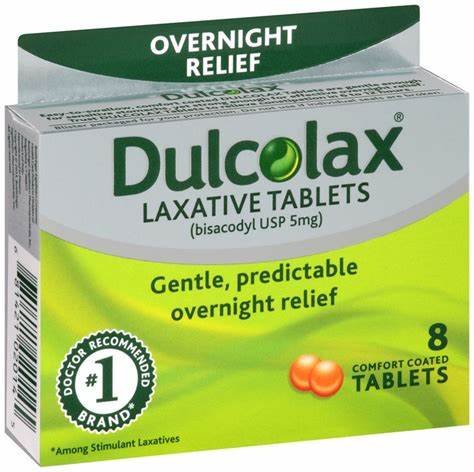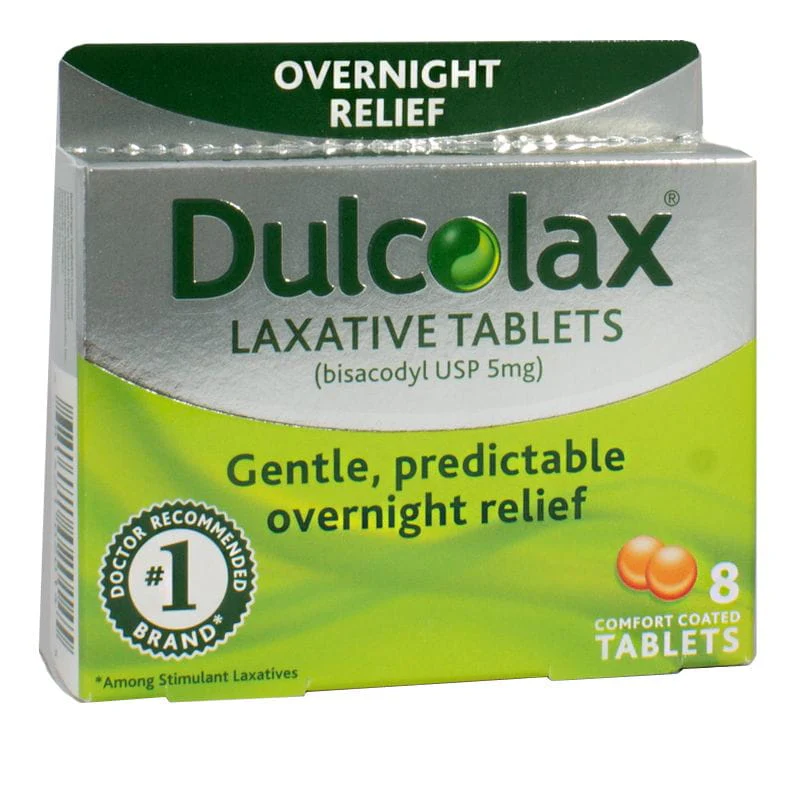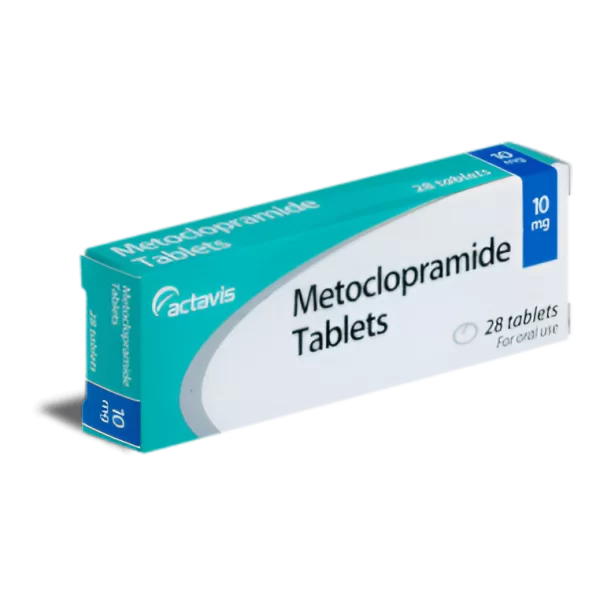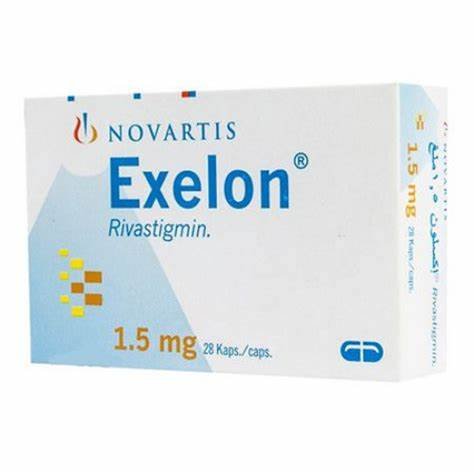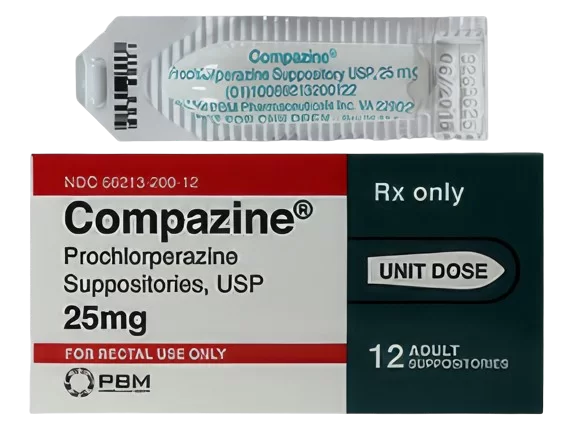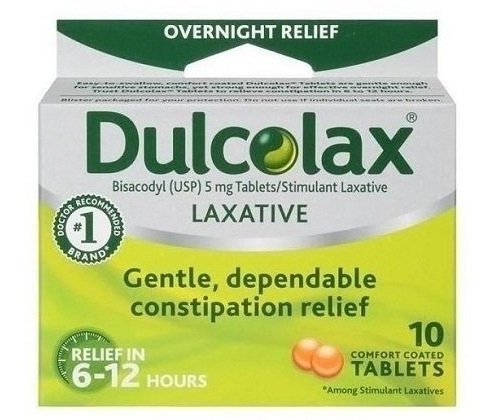
Dulcolax
Dulcolax - 5mg
Overview
General Introduction Dulcolax (bisacodyl) is a stimulant laxative used to treat constipation and for bowel preparation before medical procedures like colonoscopy. Developed by Boehringer Ingelheim, it has been widely used since its introduction in the mid-20th century. This medication works by stimulating the bowel muscles, increasing intestinal water content, and facilitating bowel movements.
Key Benefits and Unique Properties
- Effective Relief: Provides fast and effective relief from constipation, typically within 6-12 hours.
- Predictable Action: Its action is predictable, making it a reliable choice for bowel preparation before medical procedures.
- Various Forms: Available in different forms, including tablets, suppositories, and liquid, catering to different patient needs and preferences.
- Gentle on the Stomach: Formulated to minimize discomfort, this laxative is designed to act specifically on the colon without causing significant systemic effects.
- OTC Availability: Easily accessible over-the-counter, making it convenient for quick relief from constipation.
Effectiveness Compared to other laxatives, Dulcolax offers a reliable and predictable response, making it a preferred choice for both patients and healthcare providers. Clinical studies have demonstrated its efficacy in providing rapid relief from constipation and in effectively preparing the bowel for medical procedures. This medication's mechanism of action ensures targeted relief without significant systemic absorption, making it a safe and effective option for managing constipation.
Safety and Tolerability This stimulant laxative is generally safe and well-tolerated when used as directed. Common side effects include abdominal discomfort, cramps, and diarrhea, which are typically mild and transient. To minimize these side effects, it is recommended to follow the dosing instructions carefully. Long-term or excessive use of this medication can lead to dependence and decreased bowel function, so it is important to use it only as needed and under the guidance of a healthcare provider.
Indications for Use
Diseases and Conditions Treated
- Constipation: Indicated for the relief of occasional constipation. It helps to stimulate bowel movements and alleviate the discomfort associated with constipation.
- Bowel Preparation: Also used for bowel preparation before diagnostic procedures like colonoscopy. Ensures thorough cleansing of the bowel, allowing for accurate diagnostic results.
Primary Symptoms and Indications
- Constipation Symptoms: Helps relieve symptoms such as infrequent bowel movements, hard or dry stools, and straining during bowel movements.
- Bowel Preparation: Effective in preparing the bowel by ensuring complete evacuation, which is essential for clear visibility during diagnostic procedures.
Dosage and Administration
Dosage and Intake
- Adults and Children Over 12: The recommended dose for constipation is 5-15 mg (1-3 tablets) taken orally at bedtime. For bowel preparation, follow the specific instructions provided by the healthcare provider.
- Children 6-12: The recommended dose is 5 mg (1 tablet) taken orally at bedtime.
- Suppositories: For faster relief, adults and children over 12 can use one 10 mg suppository, and children 6-12 can use one 5 mg suppository.
Timing and Frequency
- Optimal Timing: Tablets are typically taken at bedtime to produce a bowel movement the next morning. Suppositories are used as needed for quicker relief, usually producing results within 15-60 minutes.
- Frequency: Use as needed for occasional constipation. Do not use for more than seven consecutive days without consulting a healthcare provider.
Additional Recommendations
- Hydration: Maintain adequate hydration to help facilitate bowel movements and reduce the risk of dehydration.
- Missed Dose: If a dose is missed, take it as soon as remembered unless it is almost time for the next dose. Do not double the dose to make up for the missed one.
Mechanism of Action
Description of Mechanism
- Primary Mechanism: This medication works by stimulating the enteric nerves to induce peristaltic contractions of the colon. This action helps to move stool through the bowels and promote evacuation.
- Molecular Targets: The active ingredient, bisacodyl, acts directly on the nerve endings in the colon, enhancing motility and increasing water and electrolyte secretion into the bowel.
Biochemical Processes
- Stimulation of Peristalsis: Induces peristalsis by stimulating the nerve endings in the colon, leading to increased bowel motility.
- Increased Water Content: Promotes the accumulation of water and electrolytes in the intestinal lumen, which softens the stool and facilitates its passage.
Physiological Effects
- Organ and System Functions: By stimulating bowel movements, helps to relieve constipation and prepare the bowel for diagnostic procedures.
- Therapeutic Effects: The primary therapeutic effects include relief from constipation, improved bowel regularity, and effective bowel preparation for medical procedures.
Composition
Active Ingredients
- Bisacodyl: The active ingredient in this stimulant laxative, bisacodyl, acts on the colon to promote bowel movements.
Inactive Ingredients
- Excipients: Tablets contain inactive ingredients such as lactose, maize starch, glycerol, magnesium stearate, and methacrylic acid copolymer, which help stabilize the formulation and ensure proper tablet formation and dissolution.
Side Effects
General Introduction Understanding the potential side effects is crucial for safe use. Patients should be aware of both common and serious side effects to monitor their health effectively while on the medication.
Possible Side Effects
- Common Side Effects: Abdominal discomfort, cramps, diarrhea, and nausea. These side effects are generally mild and transient, often resolving on their own without the need for medical intervention.
- Less Common Side Effects: Dizziness, fainting, and rectal irritation (with suppository use). These side effects are less frequent but should be monitored.
- Serious Side Effects: Severe dehydration, electrolyte imbalance, and allergic reactions. These side effects are rare but require immediate medical attention.
Frequency and Severity
- Common: Generally mild and transient, these side effects do not usually interfere significantly with daily activities.
- Severe: Rare but serious, requiring immediate medical attention and potentially discontinuation of the medication.
Prevention of Side Effects
General Introduction Preventing side effects is key to maximizing the therapeutic benefits. By following preventive measures, patients can reduce the likelihood of experiencing adverse reactions and maintain optimal control of their symptoms.
Tips for Prevention
- Follow Dosage Instructions: Use as directed to avoid excessive use, which can lead to dependence and decreased bowel function.
- Stay Hydrated: Adequate hydration can help reduce the risk of dehydration and electrolyte imbalance.
- Consult Healthcare Providers: Regular consultations can help manage and prevent adverse reactions. Inform your healthcare provider about any other medications or supplements you are taking to avoid potential interactions.
Contraindications
General Introduction Understanding contraindications ensures the safe use. Certain conditions and diseases may preclude the use of this medication.
Conditions and Diseases
- Allergic Reactions: Patients with a known hypersensitivity to bisacodyl or any of the excipients should not use this medication. Allergic reactions can be severe and may include symptoms such as rash, itching, swelling, and difficulty breathing.
- Intestinal Obstruction: Should not be used in patients with intestinal obstruction, as it can exacerbate the condition.
- Acute Abdominal Conditions: Patients with acute abdominal conditions, such as appendicitis or severe abdominal pain of unknown origin, should avoid using this medication.
- Dehydration: Patients who are severely dehydrated should not use this medication, as it can worsen their condition.
Warnings/Precautions
General Introduction Following precautions is essential to ensure the safe and effective use. Patients should be informed about potential risks and how to mitigate them.
Important Warnings
- Electrolyte Imbalance: Chronic use or overuse can lead to electrolyte imbalance. Patients should be monitored for signs of electrolyte disturbances, such as muscle weakness, cramps, or irregular heartbeat.
- Dehydration: Can cause significant fluid loss, leading to dehydration. It is important to maintain adequate fluid intake while using this medication.
- Rectal Irritation: Suppository use may cause rectal irritation. If significant discomfort or irritation occurs, patients should discontinue use and consult a healthcare provider.
Precautions
- Regular Monitoring: Regular check-ups and monitoring of electrolyte levels and hydration status are essential to detect and manage side effects early.
- Drug Interactions: Regular review of all medications by healthcare providers is recommended to prevent adverse interactions. Patients should inform their healthcare providers about all medications, including over-the-counter drugs and supplements.
Missed Dose
General Introduction Proper management of missed doses helps maintain effective symptom control. Patients should be aware of how to handle missed doses to avoid disruptions in their treatment regimen.
What to Do If a Dose Is Missed
- Immediate Action: Take the missed dose as soon as remembered if it is within a reasonable timeframe. If it is almost time for the next scheduled dose, skip the missed dose.
- Next Scheduled Dose: Do not double the dose to make up for a missed one. Continue with the regular dosing schedule to maintain consistent drug levels.
Tips for Adherence
- Reminders: Use alarms or medication organizers to help remember to take this medication as prescribed.
- Routine: Take at the same time each day to develop a routine and reduce the chances of missing a dose.
Drug Interaction
General Introduction Understanding potential drug interactions helps in avoiding adverse effects and ensuring the effectiveness. Patients should be aware of common interactions and how to manage them.
Examples of Interactions
- Diuretics: Concomitant use with diuretics can increase the risk of electrolyte imbalance. Patients should be monitored closely for signs of dehydration and electrolyte disturbances.
- Antacids: Taking with antacids can reduce its effectiveness and increase the risk of stomach irritation. It is recommended to space out the dosing of these medications.
- Other Laxatives: Using multiple laxatives concurrently can increase the risk of severe diarrhea and dehydration. Patients should consult their healthcare provider before combining laxatives.
How to Avoid Negative Interactions
- Medication Review: Regularly review all medications with healthcare providers to identify and manage potential interactions before they cause adverse effects.
- Inform Healthcare Providers: Always inform healthcare providers of all medications being taken, including over-the-counter drugs and supplements, to ensure safe and effective use.
Overdose
Symptoms of Overdose
- Mild Symptoms: Nausea, vomiting, diarrhea, and abdominal cramps. These symptoms may occur with mild overdose and require supportive care.
- Severe Symptoms: Severe dehydration, electrolyte imbalance, and cardiovascular complications. Immediate medical intervention is necessary for severe overdose cases.
Actions to Take in Case of Overdose
- Immediate Measures: Seek emergency medical attention or call a poison control center immediately if an overdose is suspected.
- First Aid: Provide supportive care, including maintaining hydration and monitoring vital signs until medical help arrives.
Pharmacokinetics
Absorption
- Rate and Extent: Absorbed primarily in the small intestine, with peak plasma concentrations occurring within 4-6 hours after oral administration. The onset of action is typically within 6-12 hours.
- Factors Influencing Absorption: Food and other medications can influence the absorption, potentially delaying its onset of action.
Distribution
- Distribution in the Body: Distributed throughout the body, with a primary focus on the colon where it exerts its effects.
- Concentration in Tissues: Higher concentrations are found in the colon, facilitating its laxative action.
Metabolism
- Metabolic Pathways: Metabolized in the liver to its active form, bis-(p-hydroxyphenyl)-pyridyl-2-methane (BHPM), which then acts on the colon to stimulate bowel movements.
- Impact on Efficacy: The metabolism helps to activate the drug and target its action specifically to the colon.
Elimination
- Primary Route: Excreted primarily via the feces, with a smaller amount excreted in the urine. This route of elimination helps to minimize systemic effects.
- Half-Life: The elimination half-life is approximately 16 hours, supporting its once-daily dosing regimen for constipation relief.
Dosage Forms
Available Forms and Dosages
- Tablet Form: Available in enteric-coated tablets for oral administration. The enteric coating helps to ensure the tablet reaches the colon before dissolving, minimizing stomach irritation.
- Suppositories: Provide faster relief by directly stimulating the rectum. Available in 10 mg doses for adults and 5 mg doses for children.
- Liquid Form: Provides an alternative for those who have difficulty swallowing tablets. The liquid form acts quickly and is easy to administer.
Advantages of Each Form
- Tablets: Convenient and easy to administer, suitable for long-term treatment.
- Suppositories: Ideal for patients needing quick relief or those who cannot take oral medications.
- Liquid Form: Provides a versatile option for patients with swallowing difficulties or those who prefer liquid medication.
Pregnancy and Breastfeeding
Safety of Use
- Risk Assessment: Classified as Pregnancy Category B. Animal studies have not shown any risk to the fetus, but there are no adequate and well-controlled studies in pregnant women. Should be used during pregnancy only if clearly needed.
- Research dаta: Limited data are available on the use during pregnancy. Healthcare providers should consider alternative treatments for pregnant women whenever possible.
Recommendations for Pregnant and Nursing Mothers
- Pregnancy: Use with caution during pregnancy, especially in the third trimester. Pregnant women should consult their healthcare provider before using this medication.
- Breastfeeding: It is not known whether bisacodyl is excreted in human milk. Due to the potential for serious adverse reactions in nursing infants, a decision should be made whether to discontinue nursing or discontinue the drug, taking into account the importance of the drug to the mother.
- Consultation: Pregnant and nursing mothers should consult their healthcare provider before starting or continuing this medication. Comprehensive risk-benefit analysis is essential to ensure the safety of both mother and child.
Storage Conditions
Storage Recommendations
- General Guidelines: Store at room temperature between 20°C to 25°C (68°F to 77°F). Protect from light and moisture. These conditions help to maintain the stability and effectiveness of the medication.
- Specific Instructions: Keep the medication in its original container, tightly closed, and out of reach of children. Proper storage prevents accidental ingestion and preserves the quality of the tablets.
Temperature and Other Conditions
- Temperature: Do not store in extreme temperatures (above 30°C or below 15°C). Avoid exposure to excessive heat, which can degrade the active ingredient.
- Moisture Protection: Protect from moisture to prevent tablet degradation. Store in a dry place, away from high humidity environments such as bathrooms.
- Shelf Life: Check the expiration date on the packaging and do not use the medication past this date. Proper adherence to storage guidelines ensures the medication remains effective throughout its shelf life.
Clinical Trials and Efficacy
Overview of Clinical Trials
- Trial Design: Evaluated in numerous clinical trials to assess its efficacy and safety in treating constipation and for bowel preparation. These studies typically involve large patient populations with various demographics and conditions.
- Research Methods: Trials often compare with placebo or other laxatives. The primary endpoints include time to bowel movement, ease of bowel movement, and overall patient satisfaction.
Key Findings and Conclusions
- Efficacy: Clinical trials consistently show that Dulcolax significantly reduces the time to bowel movement compared to placebo. Patients using this medication report substantial improvements in bowel regularity and overall satisfaction.
- Comparison: The efficacy is comparable to other stimulant laxatives and superior to placebo. It is particularly effective for bowel preparation, ensuring thorough cleansing before medical procedures.
- Safety: The safety profile is well-documented, with a low incidence of severe side effects when used as directed. Long-term studies confirm its tolerability and continued effectiveness over extended periods.
Conclusion
Summary of Key Points
- Comprehensive Overview: Dulcolax (bisacodyl) is an effective and well-tolerated stimulant laxative for managing constipation and bowel preparation. Its mechanism of action involves stimulating bowel motility and increasing water content in the intestines.
- Efficacy and Safety: Clinical trials have demonstrated its ability to provide rapid relief from constipation and effective bowel preparation, while maintaining a favorable safety profile.
Primary Benefits and General Recommendations
- Key Benefits: Offers several advantages, including its fast and predictable action, various dosage forms, and over-the-counter availability. These features make it a valuable option for managing constipation and preparing the bowel for medical procedures.
- Recommendations: Patients and healthcare providers should consider for effective constipation relief and bowel preparation. Regular monitoring and adherence to dosing instructions enhance its safety and efficacy.
